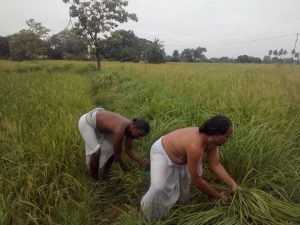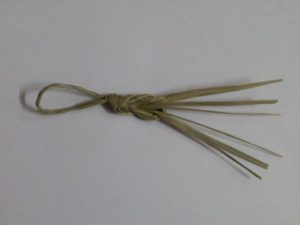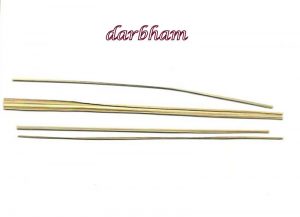darbha/kusha दर्भ/कुश
“darbha दर्भ” is a rhizomatous perennial grass found in damp marshy and low-lying areas. Its botanical name is “desmostachya bipinnata”. darbha is also known by the name Kusha कुश or बर्हिस् barhis. The word “kusha” means “that which removes sins”. Darbha or Kusha कुश is commonly known by the names Halfa grass, Big cord grass, and Salt reed-grass. The kusha grass grows up to 60cm tall; its rhizomes are 2–3 mm thick and 20–30 cm deep. The Leaves are coarse, narrow, tough and often rolled. They are pointed at the top. The blades are so sharp that if handled carelessly they can cut through the skin.
Kusha or darbha are extensively used in Hindu rituals because of their highly protecting and conducting properties.
1. kusha or darbha is used to make rings which are worn in the right hand ring finger. This kusha ring is called a “pavitram पवित्रम्”. Pavitram is used in all vaidika karmas.
2. darbhas are used to make “bhugnam भुग्नम्” for use in pitRu karmas.
3. A bunch of darbhas tied together is called “darbha koorcham दर्भ कूर्चम्”.
4. darbhas are laid around the four sides of the sacrificial agni in hOmams/yagyas. (paristaraNam परिस्तरणम्)
5. darbhas are used as Asanas/seats called “darbhAsanam दर्भासनम्” during vaidika karmas.
6. Mats made of kusha grass are used for meditation/japa to enhance concentration. A cloth is placed on the kusha mat and then used for meditation.
7. darbhas are dipped in water with the accompaniment of vedic mantras. The charged water is then sprinkled on the head and around the house or any place for purification. (prOkShaNam).
8. kusha varieties like munja are also used to make strings or ropes. The strings are used to be tied as maunjee around the waist of a brahmachaaree.
9. The essence of ground kusha grass is used to make Kusha oil. It is mixed with other oils and used in summer for cooling effect and also in the treatment of many diseases.
Sage gObhila says:
कुशमूले स्तिथो ब्रह्मा कुशमध्ये तु केशव: ।
कुशाग्रे शङ्करं विद्यात् सर्वे देवा: समन्तत: । ।
kushamoolEsthitO brahmA kushamadhyE tu keshava:
kushAgrE shankaram vidyAt sarvE dEvA: samantata:..
Lord brahamA resides at the base/roots of the kusha grass, Lord kEshava resides in the middle part and Lord shankara resides in the top portion and all the other devas reside on all the four sides.
Sage hArita says:
कुशहस्तेन यज्जप्तं दानम् चैव कुशैस्सह ।
कुशहस्तस्तु यो भुंङ्क्ते तस्य सङ्ख्या न विद्यते । ।
kushahastena yajjaptaM dAnam chaiva kushaissaha.
kushahastastu yo bhungktE tasya sankhyA na vidyate.
The merits of meditation (japa), charity (daanam) and meal eaten (bhunkte) with kusha in the hand are countless.
कुशमालां तु य: कण्ठे समावहति सर्वदा ।
लिप्यते न स पापेन पद्मपत्रमिवाम्भसा । ।
करे कण्ठे शिखायां च कर्णयोरुभयोरपि ।
पवित्रधारको यश्च न स पापेन लिप्यते । ।
kushamAlAM tu ya: kaNThe samAvahati sarvadA.
lipyate na sa pApEna padmapatramivAmbhasA..
kare kaNThe shikhAyAM cha karNayorubhayorapi.
pavitradhArakO yashcha na sa pApEna lipyate.
No sin touches one who wears a necklace made of kusha, just like water doesnt’t stick on a lotus leaf. One who has kusha in his hand, neck, ears or shikha does not sin.
darbha/kusha grasses grows in marshy areas and river sides. They grow on their own. They should be collected on a specific day carefully. darbhas collected from fields where sesame/til is grown are the most preferred ones.
darbha sangraham दर्भ सङ्ग्रहम्
hAreeta smRuti says:
माघे नभस्यमा या स्यात्तस्यां दर्भॊच्चयो मत: ।
अयातयामास्ते दर्भा: नियोज्या: स्यु: पुन: पुन: ॥
mAghE nabhasyamA yA syAttasyAM darbhOcchayo mata:
ayAtayAmAste darbhA: niyojyA: syu: puna: puna:.
darbhas are collected from the fields only on the following two days of the year.
1. mAgha/mAsi month amAvAsya
2. shrAvan/Avani month amAvAsya
The darbhas so collected can be stored and used at any time for karmas but until one year only. It is said that the darbhas collected on these two days do not have the yAtayAma dOsha (expiry) until one year.
darbhas are not cut in the evening or night. They can be cut only in the morning/forenoon.
1. darbha sangraham दर्भ सङ्ग्रहम्
darbhas are collected by priests from the fields after uttering specific mantras. They are allowed to dry and then twisted into pavitrams, bhugnams, maunjees,, etc.

2. darbha sankhya दर्भ सङ्ख्या
For dEva kArya :- 2 darbhas are used.
For pitRu kArya:- 3 darbhas are used.
1. darbhas picked up from the following places should not be used for vaidika karmas.
1. Shady place.
2. Pathway/road.
3. Unclean places.
4. Those already used in a pitRukArma.
5. Those already used for Asanam while performing brahmayagyam.
6. places where yagyas were performed.
7. darbhas used in paristaraNam in hOmams/yagyas.
8. darbhas which do not have the sharp tips
9. darbhas cut by nails
10. darbhas that are burnt
2. When kusha grass is not available, other grass varieties have may be used as darbha. A few of them are:-
1. kAsha (Saccharum spontaneum)
2. dhoorva (Cynodon dactylon)
3. daaraa (vaishvAmitram)
The atharva vEda extols the darbha as a purifying, protecting and life-prolonging plant. There may be many versions of the explanation to these verses. A simple contextual and interesting meaning is given here.
इमम् बध्नामि ते मणिं दीर्घायुत्वाय तेजसे । दर्भं सपत्नदम्भनं द्विषतस्तपनं हृद:।।
imam badhnAmi tE maNiM deerghAyutvAya tEjasE. darbhaM sapatnadambhanaM dviShatastapanaM hRuda:.
atharva vEda kANDa 19.32.1 अथर्व वॆद काण्ड १९.३२.१
शतकाण्डो दुश्चयवन: सहस्रपर्ण उत्तिर: । दर्भो य उग्र ओशधिस्तं ते बध्नाम्यायुषे ।।
shatakANDo dushchayavana: sahasraparNa uttira:
darbho ya ugra oshadhistaM tE badhnAmyAyuShE.
यो जायमन: पृथिवीमदुंहद्यो अस्तभ्नादन्तरिक्षं दिवं च । यं बिभ्रतं ननु पाप्मा विवेद स नोऽयं दर्भो वरुणो दिवा क: ।।
yo jAyamana: pRuthiveemaduMhadyO astabhnAdantarikShaM divaM cha. yaM bibhrataM nanu paapmA vivEda sa nOayaM darbhO varuNO divA ka:.!!
atharva vEda kANDa 19.32.2 अथर्व वॆद काण्ड १९.३२.2 नास्य केशान्प्र वपन्ति नोरसि ताडमा घ्नते । यस्मा अच्छिन्नपर्णेन दर्भेण शर्म यच्छति ।। nAsya kEshAnpra vapanti nOrasi taaDamA ghnatE. yasmA achChinnaparNEna darbhENa sharma yachChati!!
दिवि ते तूलमोषधे पृथिव्यामसि निष्ठित: । त्वया सहस्रकाण्डेनायु: प्र वर्धयामहे । ।
divi tE toolamOShadhE pRuthivyAmasi niShThita:tvayA sahasrakANDEnAyu: pra vardhayAmahE.
atharva vEda kANDa 19.32.4. अथर्व वॆद काण्ड १९.३२.४. तिस्रो दिवो अत्यतृणतिस्र इमा: पृथिवीरुत । त्वयाहं जिह्वां नि तृणद्भि वचांसि । । tisro divO atyatRuNatisra imaa: pRuthiveeruta. tvayAhaM jihvAM ni tRuNadbhi vachAMsi.
arva vEda kANDa 19.32.10. अथर्व वॆद काण्ड १९.३२.१०. सपत्नह शतकण्ड: सहस्वानोषधीनां प्रथम: सं बभूव । स नोऽयं दर्भ: परि पातु विश्वतस्तेन साक्षीयपृतन्यत: ।। sapatnaha shatakaNDa: sahasvAnOShadheenAM prathama: saM babhoova. sa nOayaM darbha: pari pAtu vishvatastEna sAkSheeyapRutanyata:.





